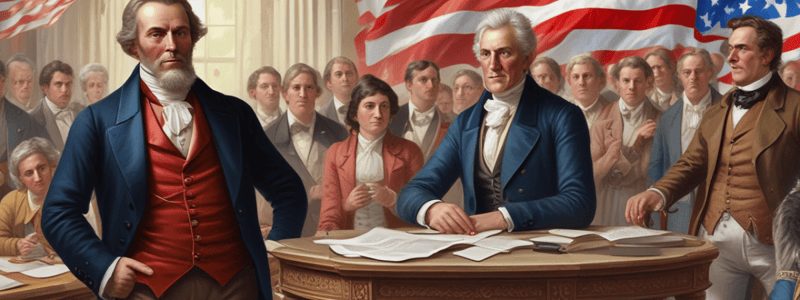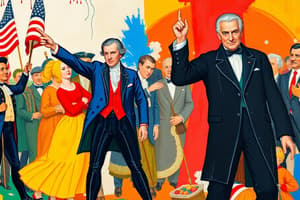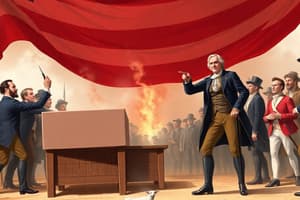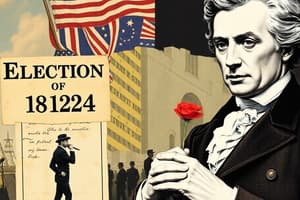Podcast
Questions and Answers
Which region in the United States was most responsible for the large-scale production of cotton as a cash crop from 1807-1890s?
Which region in the United States was most responsible for the large-scale production of cotton as a cash crop from 1807-1890s?
- South (correct)
- West
- North
- East
What term was used to describe the alleged deal between John Quincy Adams and Henry Clay in the 1824 election?
What term was used to describe the alleged deal between John Quincy Adams and Henry Clay in the 1824 election?
- Corrupt Bargain (correct)
- Political Conspiracy
- Dishonest Agreement
- Backroom Deal
What was the primary motivation behind the Temperance Movement in the 19th century?
What was the primary motivation behind the Temperance Movement in the 19th century?
- Promote alcohol consumption
- Advocate for increased taxation on alcohol
- Ban the sale and consumption of alcohol (correct)
- Encourage social gatherings
Which political party was formed as a result of the 1824 election controversy?
Which political party was formed as a result of the 1824 election controversy?
Which prominent female figures led the Women's Rights Movement during The Age of Jackson?
Which prominent female figures led the Women's Rights Movement during The Age of Jackson?
What was the reason behind the nickname "jackass" for the Democratic Party?
What was the reason behind the nickname "jackass" for the Democratic Party?
What major infrastructure project was completed during John Quincy Adams' presidency?
What major infrastructure project was completed during John Quincy Adams' presidency?
Which American authors criticized the industrial changes of their time and advocated for a return to nature through their writings?
Which American authors criticized the industrial changes of their time and advocated for a return to nature through their writings?
Which of the following best describes the concept of "Jacksonian Democracy"?
Which of the following best describes the concept of "Jacksonian Democracy"?
What was the primary objective of the Declaration of Sentiments drafted during the Seneca Falls Convention in 1848?
What was the primary objective of the Declaration of Sentiments drafted during the Seneca Falls Convention in 1848?
Approximately how many Americans were eligible to vote in the 1824 presidential election?
Approximately how many Americans were eligible to vote in the 1824 presidential election?
Who was the Black Preacher that led a slave revolt in Virginia in 1831, resulting in harsher slave codes?
Who was the Black Preacher that led a slave revolt in Virginia in 1831, resulting in harsher slave codes?
What was the term used to describe the negative campaigning tactics employed by Andrew Jackson and John Quincy Adams in the 1828 election?
What was the term used to describe the negative campaigning tactics employed by Andrew Jackson and John Quincy Adams in the 1828 election?
What significant development occurred due to the efforts of Horace Mann and Henry Bernard in the education sector?
What significant development occurred due to the efforts of Horace Mann and Henry Bernard in the education sector?
Who did not have the right to vote during the era of Jacksonian Democracy?
Who did not have the right to vote during the era of Jacksonian Democracy?
How would you describe John Quincy Adams' presidency based on the information provided?
How would you describe John Quincy Adams' presidency based on the information provided?
What was the approximate number of eligible voters in the United States by 1840?
What was the approximate number of eligible voters in the United States by 1840?
What was the primary reason behind Jackson's spoil system?
What was the primary reason behind Jackson's spoil system?
What was the main issue behind the Nullification Crisis involving South Carolina?
What was the main issue behind the Nullification Crisis involving South Carolina?
What was the outcome of the Supreme Court case Worcester v. Georgia regarding Native American rights?
What was the outcome of the Supreme Court case Worcester v. Georgia regarding Native American rights?
What was the primary reason behind Jackson's opposition to the Second Bank of the United States?
What was the primary reason behind Jackson's opposition to the Second Bank of the United States?
What was the primary cause of the Industrial Revolution in the United States?
What was the primary cause of the Industrial Revolution in the United States?
What was the significance of the Erie Canal?
What was the significance of the Erie Canal?
What was the primary purpose of the American System proposed by Henry Clay?
What was the primary purpose of the American System proposed by Henry Clay?
What was the significance of the Lowell Mills in Massachusetts?
What was the significance of the Lowell Mills in Massachusetts?
What was the primary purpose of the Cumberland Road?
What was the primary purpose of the Cumberland Road?
What was the significance of Robert Fulton's steamboat, the Clermont?
What was the significance of Robert Fulton's steamboat, the Clermont?
Which movement aimed to ban the consumption of alcohol due to concerns about domestic abuse and financial irresponsibility?
Which movement aimed to ban the consumption of alcohol due to concerns about domestic abuse and financial irresponsibility?
Who were the leading figures advocating for women's rights during The Age of Jackson?
Who were the leading figures advocating for women's rights during The Age of Jackson?
Which American author wrote 'Civil Disobedience' and protested against industrial changes that distanced people from nature?
Which American author wrote 'Civil Disobedience' and protested against industrial changes that distanced people from nature?
What was the primary motivation behind the Common School Movement?
What was the primary motivation behind the Common School Movement?
Who was known as a former slave and abolitionist who published the newspaper 'North Star'?
Who was known as a former slave and abolitionist who published the newspaper 'North Star'?
What was the purpose of the Seneca Falls Convention in 1848?
What was the purpose of the Seneca Falls Convention in 1848?
Which movement emerged as a response to the lack of proper care for people with mental and physical disabilities?
Which movement emerged as a response to the lack of proper care for people with mental and physical disabilities?
Who is associated with the creation of Utopian Societies like New Harmony and Oneida Community?
Who is associated with the creation of Utopian Societies like New Harmony and Oneida Community?
'King Cotton' was a term used to describe which crop that dominated Southern exports in America from 1807-1890s?
'King Cotton' was a term used to describe which crop that dominated Southern exports in America from 1807-1890s?
'Gag Rule' in Congress banned mentioning what controversial topic during debates?
'Gag Rule' in Congress banned mentioning what controversial topic during debates?
What was the main criticism against John Quincy Adams during his presidency?
What was the main criticism against John Quincy Adams during his presidency?
What was the primary reason behind the formation of the Democratic Party?
What was the primary reason behind the formation of the Democratic Party?
Which group did not gain the right to vote during the era of Jacksonian Democracy?
Which group did not gain the right to vote during the era of Jacksonian Democracy?
What was the nickname given to the Democratic Party, and what was the reason behind it?
What was the nickname given to the Democratic Party, and what was the reason behind it?
What significant infrastructure project was completed during John Quincy Adams' presidency?
What significant infrastructure project was completed during John Quincy Adams' presidency?
What was the approximate number of eligible voters in the United States in 1824?
What was the approximate number of eligible voters in the United States in 1824?
Which of the following best describes the concept of 'Jacksonian Democracy'?
Which of the following best describes the concept of 'Jacksonian Democracy'?
What was the primary reason behind the 'mudslinging' tactics employed by Andrew Jackson and John Quincy Adams in the 1828 election?
What was the primary reason behind the 'mudslinging' tactics employed by Andrew Jackson and John Quincy Adams in the 1828 election?
What was the approximate number of eligible voters in the United States by 1840?
What was the approximate number of eligible voters in the United States by 1840?
What was the primary motivation behind Andrew Jackson's opposition to the Second Bank of the United States?
What was the primary motivation behind Andrew Jackson's opposition to the Second Bank of the United States?
What was the primary purpose of Jackson's 'spoil system' or 'Kitchen Cabinet'?
What was the primary purpose of Jackson's 'spoil system' or 'Kitchen Cabinet'?
What was the 'Tariff of Abominations' and how did it contribute to the Nullification Crisis?
What was the 'Tariff of Abominations' and how did it contribute to the Nullification Crisis?
What was the outcome of the Supreme Court case Worcester v. Georgia regarding Native American rights?
What was the outcome of the Supreme Court case Worcester v. Georgia regarding Native American rights?
What was the significance of the Erie Canal?
What was the significance of the Erie Canal?
What was the primary motivation behind Jackson's opposition to the Second Bank of the United States?
What was the primary motivation behind Jackson's opposition to the Second Bank of the United States?
What was the primary reason behind the 'Trail of Tears'?
What was the primary reason behind the 'Trail of Tears'?
What was the significance of the Lowell Mills in Massachusetts?
What was the significance of the Lowell Mills in Massachusetts?
What was the primary purpose of the American System proposed by Henry Clay?
What was the primary purpose of the American System proposed by Henry Clay?
What was the significance of Robert Fulton's steamboat, the Clermont?
What was the significance of Robert Fulton's steamboat, the Clermont?
What was the primary reason for the growth of Northern industry during the Industrial Revolution?
What was the primary reason for the growth of Northern industry during the Industrial Revolution?
Flashcards are hidden until you start studying
Study Notes
Election of 1824
- Only one political party, four people ran for office
- No one won the majority of electoral votes, so Congress picked John Q. Adams
- Andrew Jackson claimed a "Corrupt Bargain" took place between Adams and Henry Clay
- Jackson won the popular vote but lost the presidency
- The Democratic Party was formed, named because Henry Clay called Jackson stubborn as a jackass
Jacksonian Democracy
- More citizens gained the right to vote as states got rid of laws requiring property ownership to vote
- More white men could vote, increasing from 350,000 in 1824 to 2.4 million in 1840
- Jackson believed in universal white male suffrage
Andrew Jackson's Presidency
- Indian Removal Act: Jackson wanted Native Americans east of the Mississippi River to move west
- Worcester vs. Georgia: Supreme Court ruled in favor of the Native Americans, but Jackson ignored it
- Trail of Tears: 16,000 Native Americans were forcibly moved, with 4,000 deaths
Election of 1832
- Jackson won re-election
- Bank War: Jackson hated the National Bank and vetoed its renewal charter
- Jackson believed the bank was unfair to the common man
- Jackson put the nation's money in state banks (Pet Banks) and preferred hard currency (coins)
American Regions
- The North: industrialization, growing immigrant population, and economic powerhouse
- The South: agrarian society, smaller population, and less industry and transportation
- The West: growing section of America, many Americans moved west for farming and economic opportunities
Industrial Revolution
- Causes: expanded transportation, power sources, machinery improvements, and government help for businesses
- Northern Industry: fast-flowing rivers, water-powered machines, unskilled labor, and increasing population
- Samuel Slater: introduced the factory system in 1790
- Francis Lowell: introduced textile and spinning cloth in 1814
- Eli Whitney: invented the cotton gin in 1794 and interchangeable parts in 1797
American System
- Introduced by Henry Clay
- Tariffs to protect American industry, federally funded infrastructure, and a national bank
- The law did not pass as a whole, but individual components were implemented, increasing nationalism and sectionalism
Transportation and Urbanization
- National Road/Cumberland Road: safer and straighter trade routes
- Erie Canal: connected Great Lakes to the Atlantic Ocean, increasing trade in the North and connecting NYC to the West
- Robert Fulton: introduced the steamboat, allowing faster travel upstream on the Mississippi River
- George Stephenson: introduced the first railroad in the US
- Samuel Morse: invented the telegraph and Morse Code, connecting the North, South, and West
Southern Industry
- Agricultural-based economy with cash crops like cotton and tobacco
- Less population, with 1/3 being slaves
- King Cotton was the largest export in America from 1807 to 1890s
- Most of the world's cotton was grown in the South
Reform Movements
- Second Great Awakening: a religious revival that sparked reforms
- Temperance Movement: ban alcohol, led by Carrie A. Nation
- Social Reforms: Dorothea Dix helped the mentally ill, and Horace Mann and Henry Bernard introduced public education
- Women's Rights: Seneca Falls Convention promoted women's rights, and Elizabeth Cady Stanton, Lucretia Mott, and the Grimke Sisters led the movement
- Transcendentalism: authors like Ralph Waldo Emerson and Henry David Thoreau sought a simpler life away from industrialization
- Utopian Societies: communities like New Harmony and Oneida sought to create perfect societies
- Politicians sought to balance power in Congress, with "Gag Rule" restricting discussions of slavery
- Abolitionists like William Lloyd Garrison and Frederick Douglass fought against slavery
Studying That Suits You
Use AI to generate personalized quizzes and flashcards to suit your learning preferences.




